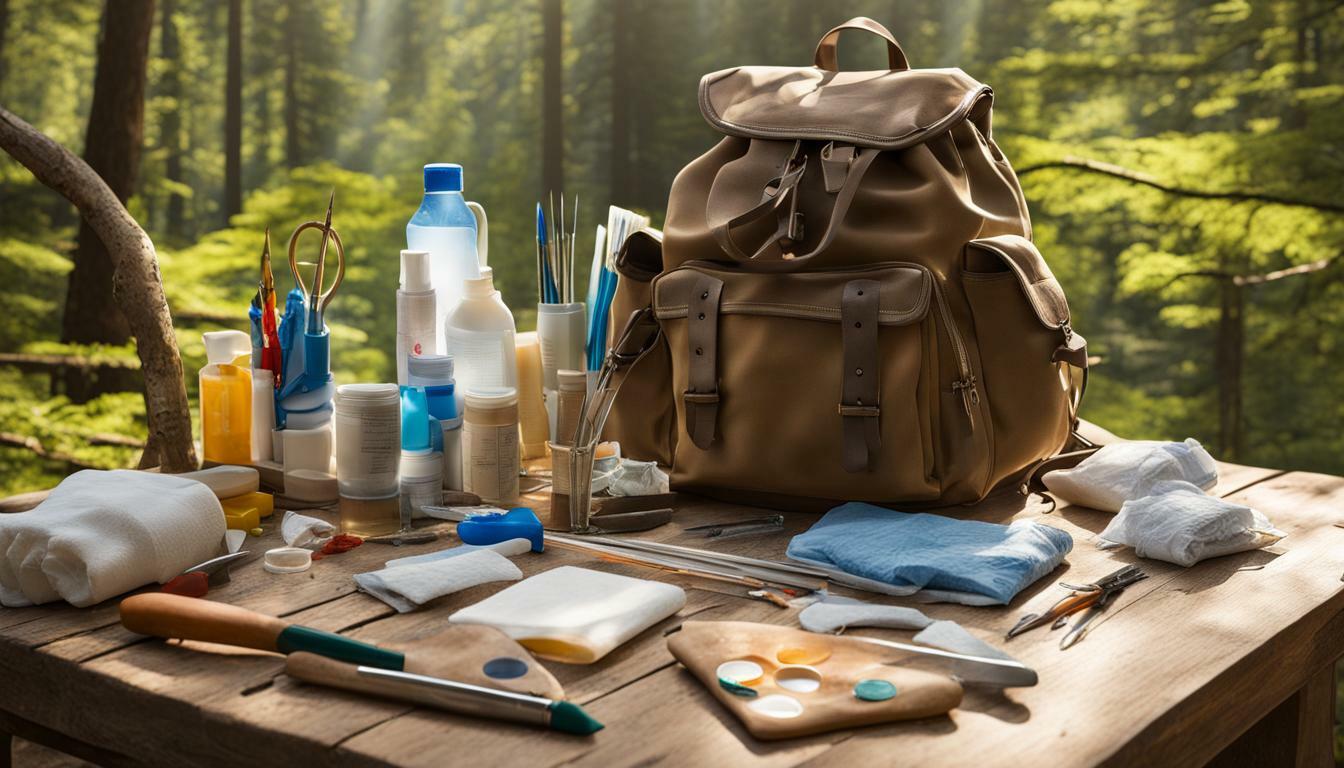As an artist who thrives in remote areas, it’s crucial to prioritize safety and be prepared for emergencies. Working in isolation can be both liberating and challenging, and it’s essential to have the right safety gear, including first aid kits, to ensure creative isolation safety.
Whether you’re hiking miles into the wilderness, traveling to a secluded artist residency, or simply working from a remote studio, having the right first aid supplies can make all the difference in case of an emergency.
Key Takeaways:
- Off-the-grid artists face unique challenges when it comes to safety, and it’s essential to be prepared for emergencies.
- Having the right first aid kit can make all the difference in case of an emergency, no matter where you are.
- Being knowledgeable in wilderness first aid and having access to emergency services are crucial for creative isolation safety.
The Importance of Artist Safety in Remote Locations
Working as an artist in remote locations offers unparalleled creative inspiration and freedom. However, it’s important to remember that with this freedom comes certain risks and hazards that need to be addressed. Artist safety in isolated locations is crucial for ensuring a transformative and successful experience.
Whether you’re a painter, sculptor or photographer, it’s important to be prepared for any situation that may arise. Equip yourself with isolation survival gear and create a safety strategy that will allow you to focus on the creative process without worrying about potential emergencies.
One of the main risks that artists face in remote locations is the lack of immediate medical assistance. In case of an injury or illness, every second counts so it’s important to have adequate first aid supplies at hand. However, in order to make the most out of your off-the-grid experience, it’s essential to think beyond basic first aid kits and consider wilderness first aid. These techniques are specifically designed for situations where professional medical help is not immediately available.
| Artist Safety Tips: | Emergency Kit Essentials: |
|---|---|
|
|
When it comes to artist safety in remote locations, it’s important to remember that it’s not just about having the right equipment. Staying informed and proactive is key to avoiding emergencies in the first place. Connect with local emergency services and learn about the area you will be working in. Knowing potential risks and hazards will allow you to prepare accordingly and avoid unnecessary accidents.
Remember to regularly check and maintain your first aid kits and emergency equipment. Expired items or damaged gear can prove fatal in an emergency situation. Stay aware and always be prepared for any situation.
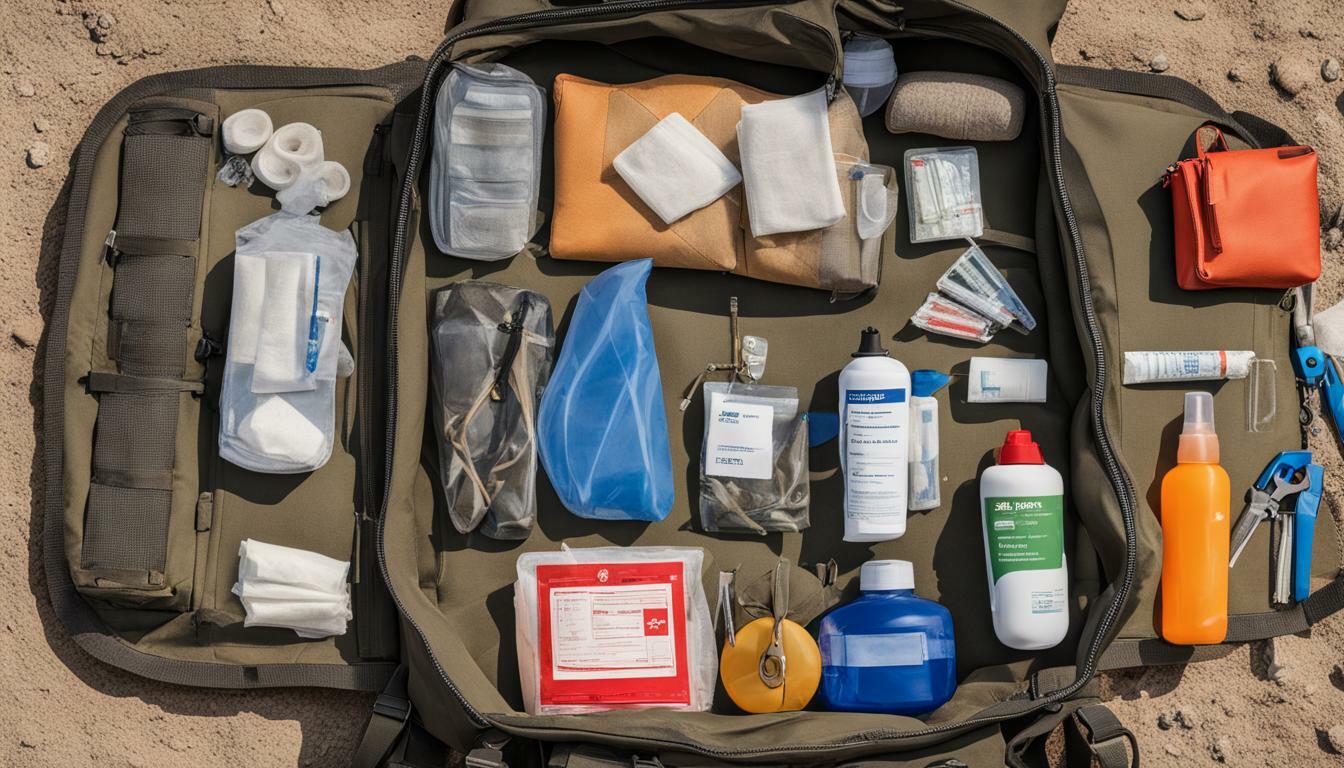
Understanding Wilderness First Aid
When it comes to emergency preparedness for off-the-grid artists, having a basic understanding of wilderness first aid can be crucial. Unlike traditional first aid, wilderness first aid focuses on providing medical care in remote locations, where emergency services may not be readily available.
Some key wilderness first aid techniques include assessing and treating injuries, managing shock, performing CPR, and providing initial wound care. It is important to note that wilderness first aid is not a replacement for professional medical training but rather a supplement to it.
In addition to being able to provide basic medical care, artists should also be prepared for emergencies by carrying essential first aid supplies. This includes items such as bandages, gauze, tape, antiseptic wipes, and pain relievers. It is important to keep these supplies in a waterproof and easily accessible container, such as a plastic bag or small first aid kit.
| Key Takeaways: |
|---|
| Wilderness first aid techniques are essential for off-the-grid artists who may not have access to emergency medical services. |
| Carrying essential first aid supplies can be life-saving in emergency situations. |
Being prepared for emergencies in remote areas is critical for the safety and well-being of off-the-grid artists. By understanding wilderness first aid and carrying essential first aid supplies, artists can take steps to ensure their safety and creative isolation.
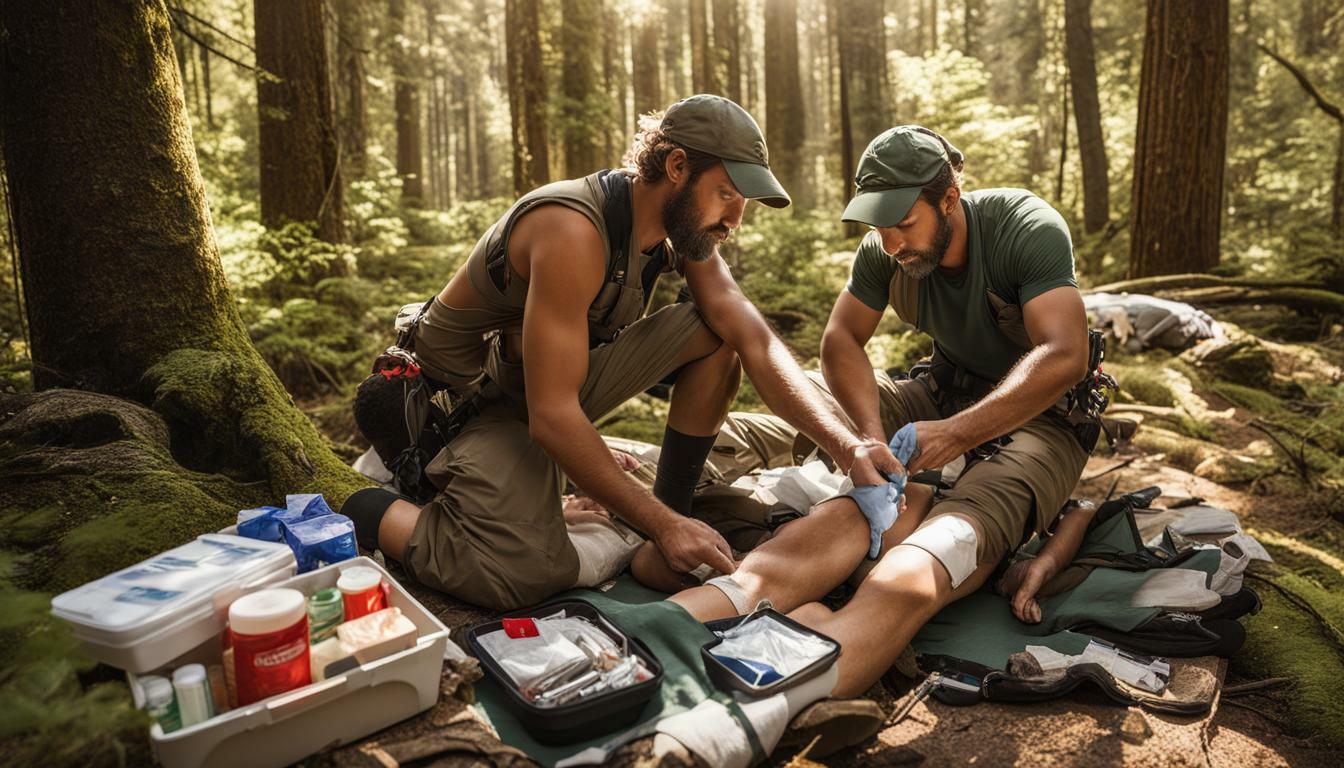
Choosing the Right First Aid Kit for Artists
When it comes to artist safety in remote areas, having the right first aid supplies is crucial. Whether you’re a painter, photographer, or writer, accidents can happen anytime and anywhere. Therefore, having a well-stocked first aid kit is essential to avoid potential risks and hazards.
Your first aid kit should contain artist first aid essentials such as adhesive bandages, alcohol wipes, gauze pads, and medical tape. These items can help you handle minor injuries such as cuts, scrapes, and burns. In case of a more severe injury, items such as a tourniquet, a CPR mask, and a splint can prove to be lifesaving.
It’s also recommended to include personal medicines such as antihistamines, pain relievers, and anti-inflammatories. Make sure to pack them in waterproof bags or containers to prevent damage due to moisture.
Additionally, consider the type of environment you’ll be working in and pack accordingly. For example, if you’ll be working in an area with high tick activity, include tick removal tools in your kit. Similarly, if you’ll be exposed to the sun for extended periods, sunscreen and sunglasses can be useful.
Remember to check your first aid supplies regularly and replenish them as needed. Keep your kit in a waterproof container and store it in an easily accessible location in your workspace or backpack. This way, you’ll be prepared for any emergency that comes your way.
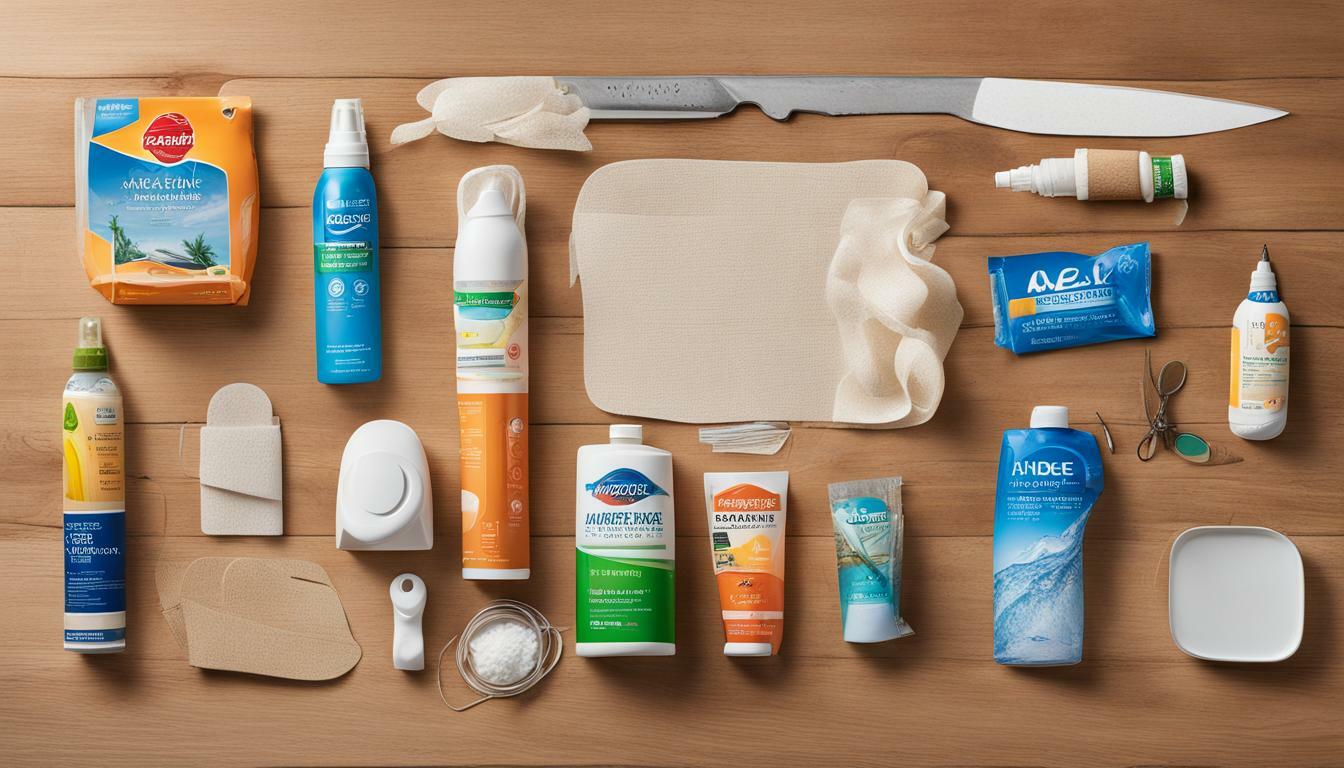
DIY First Aid Solutions for Artists
While pre-made first aid supplies are ideal for convenience, they may not always be readily available in remote locations. In such cases, being able to improvise with everyday items can make all the difference.
Here are some DIY first aid solutions for off-the-grid artists:
- Bandages: Cut up a clean t-shirt or any other cloth into strips and use them as bandages to cover wounds.
- Gauze: Sterilize a clean cloth or a feminine hygiene product and use it as gauze to soak up blood from wounds.
- Tweezers: Use a clean needle or a safety pin to remove splinters or small debris from wounds.
Remember to also include some basic medications such as pain relievers, allergy medication, and antiseptic wipes in your DIY first aid kit.
It’s essential to note that while improvised first aid solutions can work in a pinch, they should never replace professional medical care. Seek medical attention as soon as possible if an injury or illness warrants it.
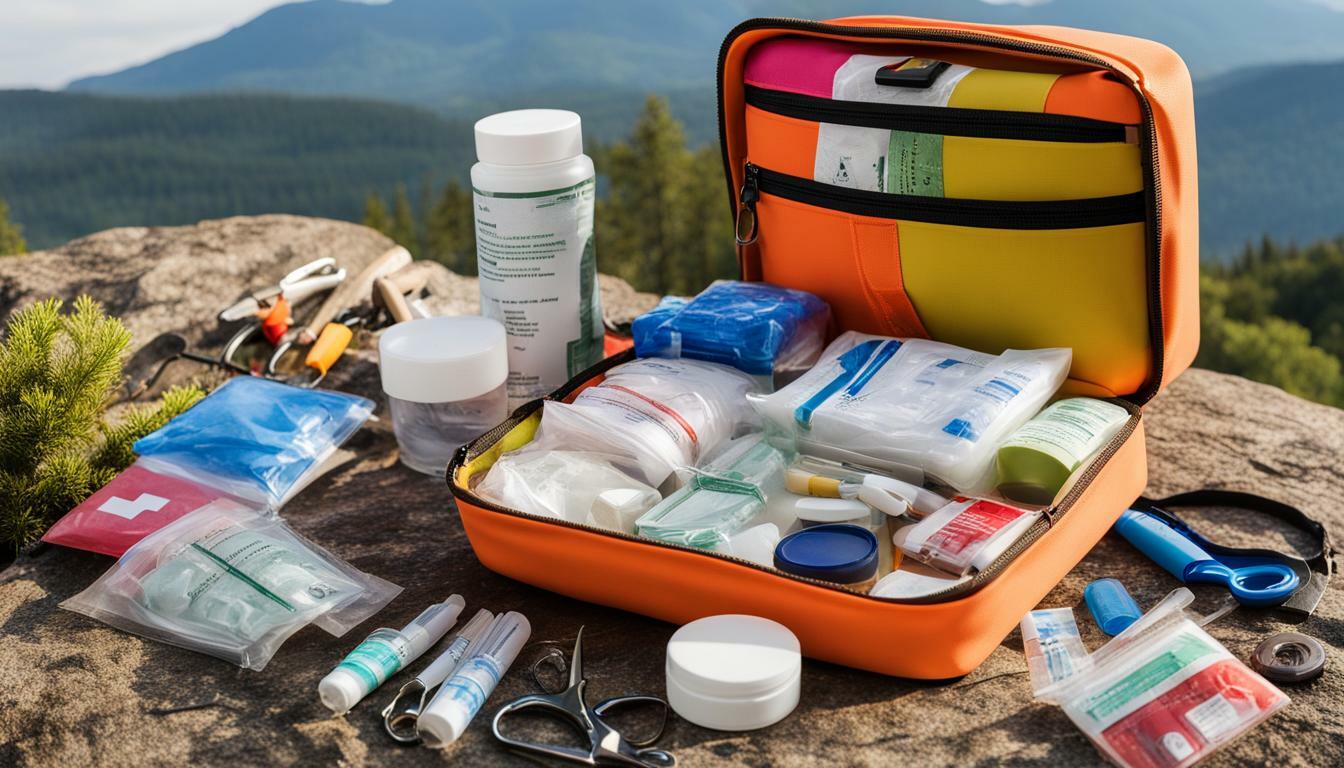
Staying Prepared: Off-the-Grid Artists’ Emergency Kits
As an off-the-grid artist, it’s crucial to have an emergency kit on hand in case of unexpected situations. Such emergencies can range from minor injuries to severe weather conditions, and having an emergency kit can make all the difference.
When building an emergency kit, it’s important to include outdoor safety equipment such as a compass, map, and flashlight. These items can be invaluable in situations where communication devices fail or navigation becomes difficult. Additionally, it’s wise to include a multi-tool, which can come in handy in many different scenarios.
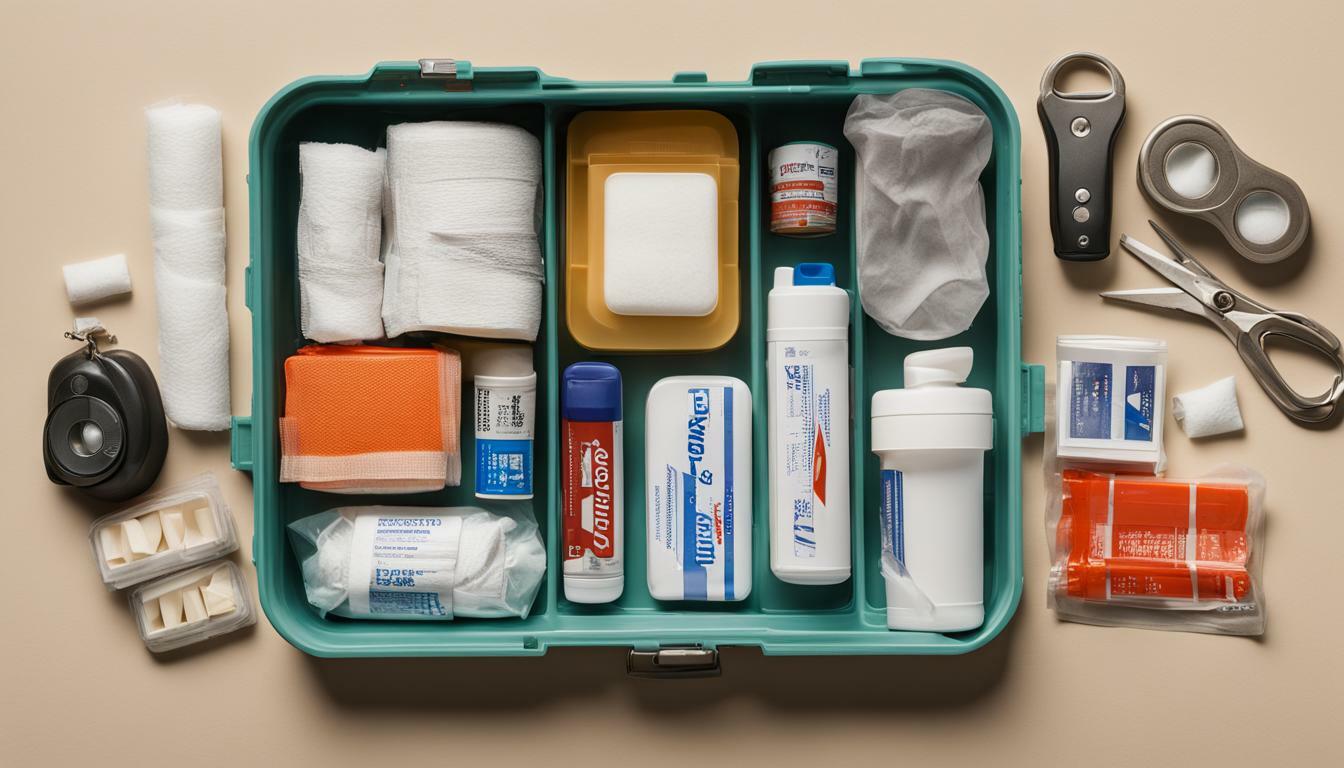
Other essential items to include in an off-the-grid artist’s emergency kit are water purification tablets, a whistle, and a thermal blanket. The water purification tablets can be used to clean water from natural sources if necessary, while the whistle can be used to signal for help. The thermal blanket can provide warmth and protection in harsh outdoor conditions.
In addition to the above items, it’s recommended to have a basic first aid kit in the emergency kit. The first aid kit should include items such as adhesive bandages, gauze pads, antiseptic wipes, and medical tape. Also, include any medications that may be needed, such as allergy medicine or pain relievers.
| Essential Items for an Off-the-Grid Artist’s Emergency Kit |
|---|
| – Compass |
| – Map |
| – Flashlight |
| – Multi-tool |
| – Water purification tablets |
| – Whistle |
| – Thermal blanket |
| – Basic first aid kit |
When putting together an emergency kit, it’s important to regularly check and replenish any expired items. As well as items, it’s also essential to review and update any emergency plans and communication devices. By staying prepared and keeping an emergency kit up to date, off-the-grid artists can stay safe and creative in any situation.
First Aid Training for Artists in Remote Areas
If you’re an artist working in remote areas, wilderness first aid training can be critical in an emergency. Knowing what to do in the event of an injury or medical emergency can save lives and prevent further injury. Even if you have a good first aid kit and other emergency supplies, you need to know how to use them properly.
Wilderness first aid training programs aim to teach people how to provide emergency medical care when they are far from civilization. In a typical course, you can expect to learn about common medical emergencies in remote areas, how to assess a patient’s condition, how to manage injuries, and how to provide basic medical care. You’ll also learn about the importance of emergency preparedness and how to minimize potential hazards.
Why is Wilderness First Aid Training Important for Artists?
Artists working in remote areas may be at a higher risk of injury due to the challenging environments they work in. A Fall while hiking to a remote location or a cut while working with tools can quickly become a medical emergency if unattended. In such cases, you may not be able to get immediate medical help. Wilderness first aid training equips you with the knowledge and skills to respond to these emergencies.
You may not be able to reach professional medical assistance quickly in remote locations. Therefore, being prepared with first aid training can make all the difference. You’ll know how to stabilize a patient’s condition, prevent further harm, and keep them comfortable until professional help arrives.
Where Can You Get Wilderness First Aid Training?
There are various organizations that offer wilderness first aid training in the UK. The Red Cross and St John Ambulance are popular options. You can also find courses provided by private companies. These programs offer a mix of classroom instruction and hands-on training. Some are intensive two-to-three-day courses, while others may be longer. Before signing up for a course, be sure to check that the instructor is experienced and that the curriculum meets your needs.
Whichever course you choose, always remember that the knowledge you gain during wilderness first aid training can make a significant difference in the outcome of an emergency.
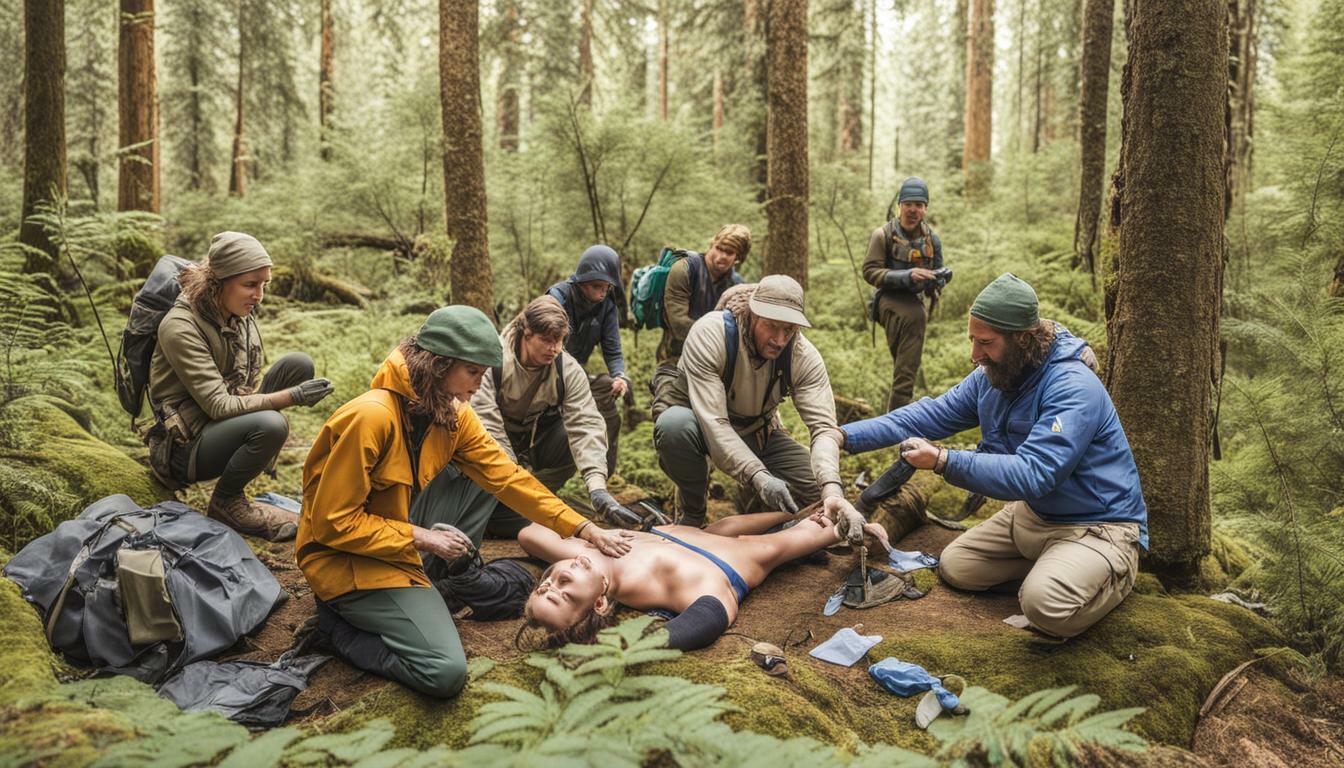
Connecting with Local Emergency Services
When working as an off-the-grid artist in remote locations, it is crucial to establish connections with local emergency services. In case of an emergency or any unexpected situation, having access to reliable services can make all the difference in ensuring your safety.
Before embarking on your creative journey, research and identify the emergency services available in the area. Store their contact information in a safe and easily accessible place. In addition, consider investing in communication devices such as radios or satellite phones to ensure you can reach out for help if needed.
It is also important to have appropriate outdoor safety equipment on hand in case of an emergency. This may include items such as emergency blankets, warm clothing, and a whistle to signal for help. Make sure to keep these items in a designated emergency kit that is easily accessible and regularly checked.

Remember, being prepared and proactive in your emergency preparedness can help prevent a difficult situation from turning into a dire one. Take the time to connect with local emergency services and stock up on the necessary outdoor safety equipment before setting out on your creative adventure.
Artist Safety Tips for Remote Locations
Working as an off-the-grid artist can be an exciting adventure, but it’s essential to prioritize safety when isolated in remote locations. Below are some artist safety tips to keep in mind:
- Protect yourself against wildlife encounters: When working in remote areas, it’s important to stay alert for the presence of potentially dangerous wildlife such as bears, snakes, and wolves. Carry bear spray and make noise to alert animals of your presence.
- Navigate unfamiliar terrain with caution: Whether exploring a new area or simply moving about your campsite, be mindful of uneven terrain and potential hazards. Wear appropriate footwear with good traction and bring a headlamp or flashlight for nighttime visibility.
- Stay safe during extreme weather conditions: Always check the weather forecast for your location and be prepared for any changes. Wear appropriate layers to stay warm in cold conditions and stay hydrated in hot weather.
- Bring outdoor safety equipment: In addition to your first aid kit, it’s important to bring additional outdoor safety equipment such as a compass, map, satellite phone or emergency beacon. These items can help you stay safe in case of an emergency.
By following these artist safety tips, you can enjoy a safe and productive off-the-grid experience while creating your masterpieces.
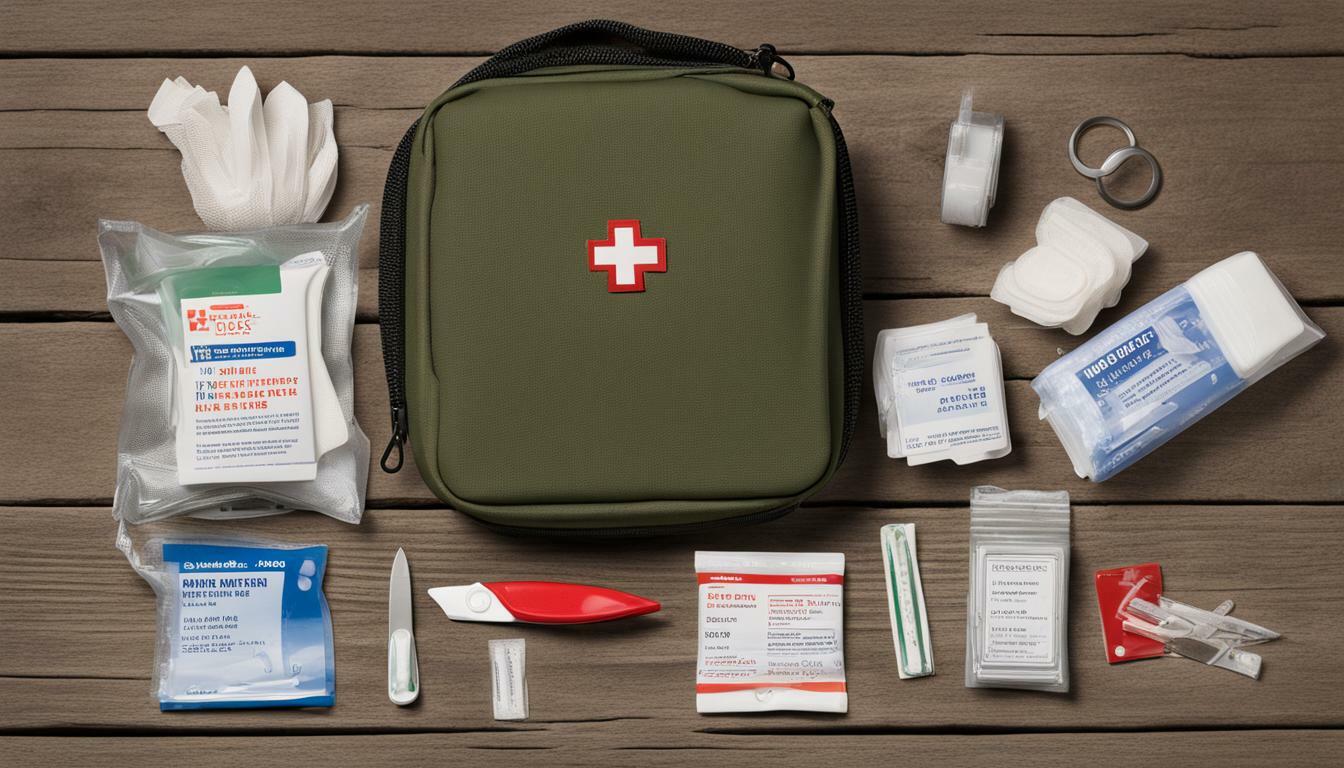
Ensuring Continuous Safety: Regular Check-ups and Maintenance
By now, you know how essential it is to have first aid kits and emergency kits as part of your creative isolation safety strategy when working off-the-grid. However, it’s not just enough to acquire these items; you need to ensure they are in good condition and fully stocked at all times to guarantee continuous safety.
Regular check-ups and maintenance are crucial in keeping your first aid supplies, safety gear, and communication devices in top condition, ready for immediate use in case of an emergency. Here are some tips to help you maintain your safety equipment:
- Inspect your first aid kit regularly: Check the contents of your first aid kit regularly to ensure all the items are in good condition and not expired. Replace expired items and restock as necessary.
- Review and update your emergency kit: Revisit your emergency kit checklist periodically and make sure all the items are up-to-date and functional. Replace any damaged, lost, or expired items.
- Charge your communication devices: Keep your communication devices charged up and ready for use. Consider investing in a portable power bank to ensure you can charge your devices when a power source is unavailable.
By following these simple maintenance tips, you can ensure continuous safety and preparedness while working as an off-the-grid artist. Remember, emergencies can happen at any time, and being prepared is the best way to stay safe.
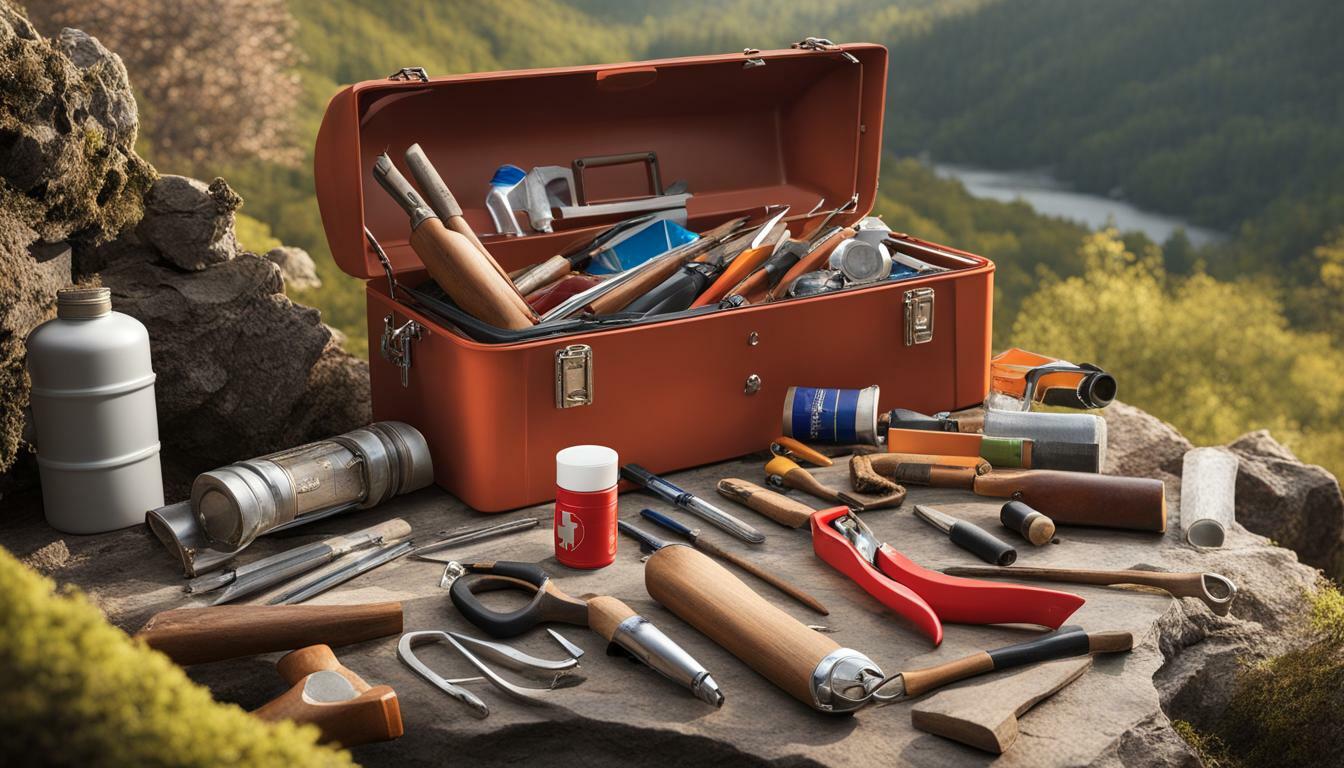
Conclusion
In remote areas, off-the-grid artists face unique challenges that demand creative solutions for safety. First aid kits are essential in ensuring creative isolation safety. These kits serve as a safety net for artists who may encounter emergencies in remote locations.
To guarantee artist safety, it is crucial to select the appropriate first aid kit with essential first aid supplies suitable for remote locations. Additionally, artists should explore DIY first aid solutions and include emergency kits in their safety strategy.
Apart from having the right safety equipment, off-the-grid artists should consider acquiring wilderness first aid skills and connecting with local emergency services to access assistance in the case of emergencies.
Regular check-ups and maintenance of first aid kits and safety equipment is also essential to guarantee continuous safety throughout the artist’s isolation period.
In conclusion, off-the-grid artists must prioritize their safety while working in remote locations by taking into account the tips and guidelines discussed in this article. These measures will ensure that artists can focus on their creative process without worrying about their safety.
